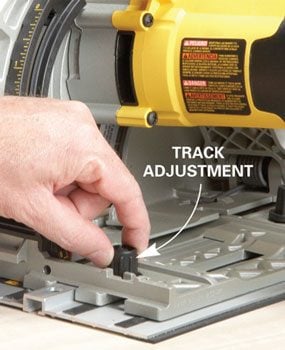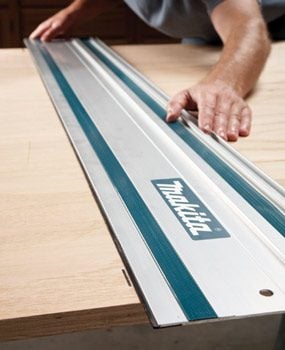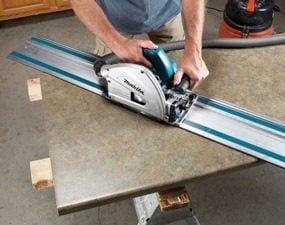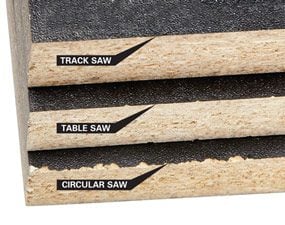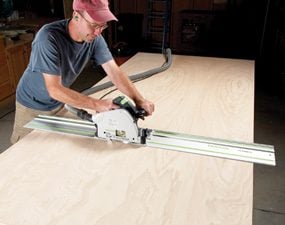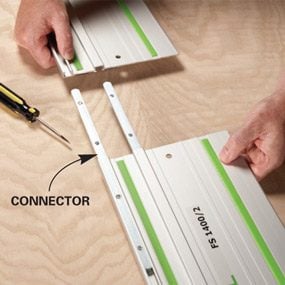Benefits of a Track Saw
Updated: Feb. 22, 2023Why you'll own one—sooner or later
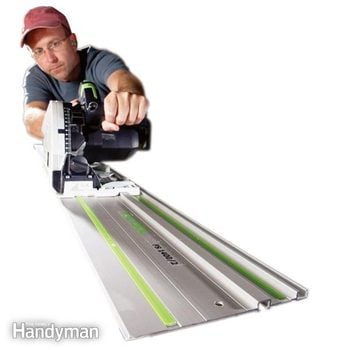
Benefit 1: It’s not just a circular saw with a fancy straightedge
When I first laid eyes on a track saw, I thought, “I have a table saw. I have a straightedge to guide my circular saw. Why would I spend $500 (or more) on one of these contraptions?” I was sure it was another tool gimmick for suckers. Then I talked to track saw owners, from cabinetmakers and flooring installers to trim carpenters and remodelers. Every single one of them told me that buying a track saw was a smart move. Now I own one too.
A track saw is similar to your framing saw—the way a Porsche is similar to a dump truck. It’s engineered to be smooth and precise rather than rugged, and you’ll feel the difference the first time you pull the trigger.
The Main Players
There are three big names in the track saw market. You’ll find the saws sold separately or as kits, with one track or two, with or without accessories. That can make price comparisons tricky, but expect to spend about $500 for a saw and a rail long enough for 4-ft. cuts. The blades are oddball sizes: 6-1/2 in. for DeWalt and Makita, 6-1/4 in. for Festool. So pick up an extra blade or two ($50 to $80 each—ouch!). Festool also makes a track saw with an 8-1/4- in. blade (TS 75; $650 for the saw only).
Benefit 2: Look Ma, no clamps!
Those sticky rubber strips on the track bottom don’t slip; no need to waste time clamping down the track in most situations—even when you’re trimming doors. Cutting clampless is scary at first, but you’ll learn to trust the sticky strips. For those rare times when you need them, get clamps that lock into the track (about $40 a pair).
Benefit 3: The dust collection system really works
The shroud on a track saw doesn’t just enclose the blade; it also creates an effective dust trap. Add a vacuum hose and you can do things you wouldn’t dream of with any other saw. Like cut MDF inside Mrs. McFussy’s house.
Video: How to Cut Straight With a Circular Saw
Benefit 4: Instant, exact setup
Just align the track with your marks and you’re ready to cut. The plastic edge shows you precisely where the blade will cut. No test cuts, no double checking, no guesswork. Again and again, track saw owners told me, “I’ve never screwed up a cut with this saw.”
Benefit 5: Nice for tight spaces
A track saw can make big cuts in a small space. If you had to, you could slice up a full sheet of plywood in an 8 x 10-ft. room. Unlike with a table saw, there’s no need for infeed or outfeed space. A track saw is also a space saver in your truck or van.
Benefit 6: Painless portability
A track saw does most of what a table saw does, but moving between job sites is a lot easier. Safer, too: Carrying a track saw, you’re less likely to bang up door casings or wreck your back. Plus, you can call Mom while you load up your truck.
Benefit 7: Long miters, no limits
With a miter saw, a table saw or even a panel saw, the length and angle of the cut are limited. Not so with a track saw. You’ll get an accurate miter no matter how long or how steep the angle. But there is one downside. Unlike those other saws, a track saw doesn’t have a built-in miter gauge, so setting up miter cuts can be slow. If you do lots of long miters, you might want to spend $50 to $100 on a miter gauge that locks onto the track.
Benefit 8: Clean, smooth cuts
I made test cuts with track saws and a top-of-the-line cabinet saw. Whether the material was solid wood, plywood or MDF, the track saw cuts were just as smooth as the table saw cuts. To test for tear-out, I added a circular saw to the contest and cut melamine. The track saws did the best, producing almost perfect cuts, with only a few tiny chips on the top of the waste piece. The table saw left tiny chips on the face-down side. The circular saw did just what you’d expect.
Is Your Table Saw Obsolete?
Nope. If you get a track saw, your table saw may get some long vacations, but it won’t go into retirement. Cutting small parts with a track saw is clumsy, and cutting much deeper than 2 in. is impossible with most models. And when it comes to identical repeat cuts—ripping wide boards into cabinet stock, for example—a track saw is a slow, sorry substitute for a table saw.
Benefit 9: Single-stage plywood cutting
To avoid wrestling heavy sheets across a table saw, many of us perform a two-act play: We rough-cut with a circular saw, then make finish cuts on a table saw. With a track saw, you can skip the second act. The first cuts will be your final cuts—every bit as straight, smooth and accurate as you’ll get on a table saw.
Benefit 10: Connect the tracks, cut for miles
The ends of the tracks are dead square, so you can lock them together for super-straight, super-long cuts. (I heard from a gym-floor installer who lays up to 100 ft. of track for a single cut!) The connectors cost about $17 each. One connector is good, but two is better. Most rails fall into one of two general categories: long enough for a 4-ft. cut (about $100) or long enough for an 8-ft. cut (about $200).

